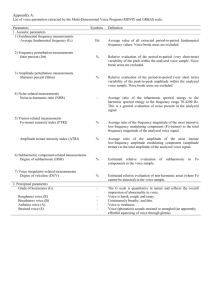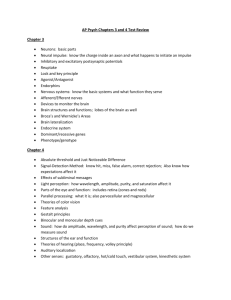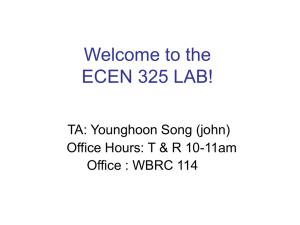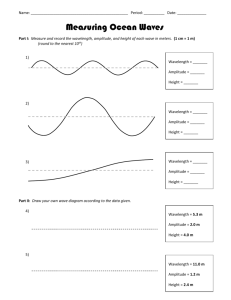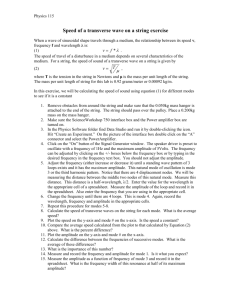doc - ray luo
advertisement
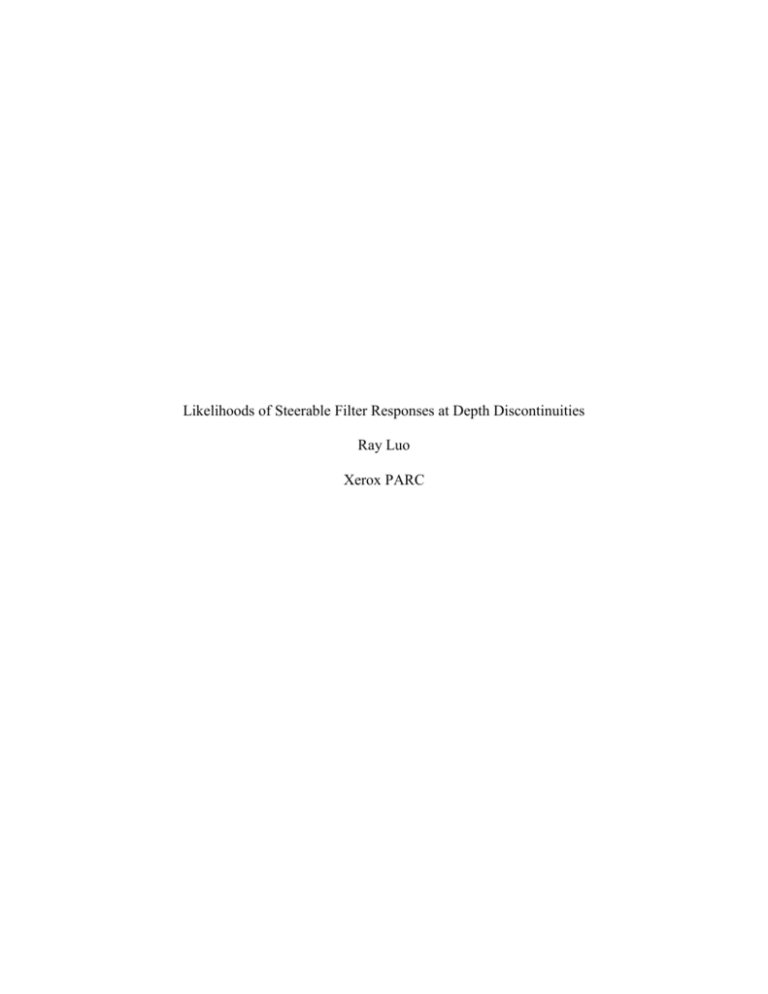
Likelihoods of Steerable Filter Responses at Depth Discontinuities Ray Luo Xerox PARC Likelihoods of Steerable Filter Responses at Depth Discontinuities In computer vision applications, we often want to know the probability of observing a set of measurements given a hypothesis about the three-dimensional scene structure. In particular, we would like to compute the probability of observing a set of filter responses given our model’s prediction about where a depth discontinuity occurs. In our case we focus on quadrature mirror pairs of filters that accept an orientation and a wavelength as parameters. These are steerable pyramid filters, i.e. filter responses at some arbitrary orientation can be computed from cached basis responses. Our depth discontinuities are hand-marked edges in a representative selection of images. The goal is to characterize phase and amplitude responses of our filters at independent samples along our edges found in a representative collection of natural images. Phase and Amplitude Responses Given edge orientation and filter wavelength, we assume that each sample of phase and amplitude observations is independent of any other sample on the image. We justify this assumption by subsampling the filter responses at every wavelength. Hence, to characterize the filter response likelihood, we simply need to characterize the likelihood for each sample of phase and amplitude response. Since the real part of the filter kernel from our quadrature mirror pair is even symmetric, we expect the real valued response at an edge to be zero. Similarly, the odd symmetry of the imaginary part of the kernel implies a highly negative or highly positive imaginary response at an edge. Thus, we expect the complex phase responses near edges to be distributed around /2. Moreover, the distribution should vary with amplitude and wavelength. At low amplitudes, noise is expected to flatten the phase distribution; at high amplitudes, sharp peaks at /2 are expected. Similarly, different wavelengths present differing amounts of disturbances from nearby edges. Amplitude distributions also vary with wavelength. At small wavelengths, there tends to be a lot of low amplitude noise, skewing the distribution. At higher wavelengths, the distribution should be broader and more Gaussian. Parametric Models For a large ensemble of edges, we expect the distribution of negative phase and that of positive phase to look the same. For our purposes, both sets of data are treated by the same model: a mixture of some symmetric, single-mode density with an outlier process. Thus we can take the phase data and wrap it into the interval [0, ]. For this phase (mod ) and log amplitude observed at edge E using filter wavelength , our probability density function at is: f( | , , E) = L( ; = /2, , k) + (1 ) where L is a generalized Laplacian distribution with parameters location , scale , and power k, that depend on and . The generalized Laplacian includes the Gaussian as a special case at k = 2. Note that , which also depends on and , denotes the ownership probability of the Laplacian for phase . In practice, we found the maximum likelihood given the phase responses using the EM Algorithm. Log amplitude histograms can be modeled by a beta distribution B at log amplitude , with parameters a and b that depend on : f( | , E) = B( ; a, b) found by parameter estimation with Matlab. With this formulation, our likelihood function for a single observation is: f(, | , E) = f( | , , E) f( | , E) Using our independence assumption across samples, the overall likelihood is the product the individual likelihoods given above. That is, the log likelihood is the sum of log likelihoods for each sample. Results Figure 2 (attached) describes the applicability of our likelihood function. Figure 3 shows a sample of four images whose edges at depth discontinuities were hand-selected using a Matlab program. The phase and amplitude responses at different wavelengths and edges for one of these images are shown in figure 4. Note how the oriented filters are tuned to a specified angle. Note also that responses at higher wavelengths have lower resolution due to subsampling that takes place in the steerable pyramid. Normalized phase probability histograms for responses collected at the marked edges are shown in figure 5. The curves fitted on the histograms are based on the parametric model described earlier, with power k fixed at 2 and fixed at /2 (i.e. Gaussian-Uniform mixture). Note that the peaks are sharper and the fits are better at higher amplitudes, because there is less noise. At very low log amplitudes (~2) the uniform process is all that is necessary to describe the distribution. The amplitude histograms at two different wavelengths are also shown in figure 5. The beta fits are somewhat better at higher wavelengths. Figure 6 shows plots of the model parameters with respect to log amplitude at two different wavelengths. Note that the ownership probability can be described by a linear model with respect to log amplitude. This suggests that we can replace the at each amplitude and wavelength with a linear parameterization at each wavelength, significantly reducing the complexity of the model. Also shown are plots of the parameter against log amplitude, showing the decreasing width of the Gaussian model at higher amplitudes. Variation of with amplitude is also systematic, but a linear fit is not sufficient to describe the dependence. Discussion Likelihoods of steerable pyramid filter outputs at depth discontinuities can be parametrically modeled by a Laplacian / Gaussian and Uniform mixture for phase and a Beta distribution for amplitude. Results show a systematic dependence of model parameters with amplitude at each filter wavelength. The next step is to refine the model by allowing the power parameter of the Laplacian to vary and by replacing model parameters by linear fits. This necessitates model comparison methodologies that compare the number of bits used to encode the different models and the goodness-of-fit of each model. References Black, M. J. and Fleet, D. J. 2000. Probabilistic detection and tracking of motion discontinuities. International Journal of Computer Vision. 38(3):229-243. Fleet, D. J. and Jepson, A. D. 1993. Stability of phase information. IEEE Transactions on Pattern Analysis and Machine Intelligence. 15(12):1253-1268. Freeman, W. T. and Adelson, E. H. 1991. The design and use of steerable filters. IEEE Transactions on Pattern Analysis and Machine Intelligence. 13:891-906.


